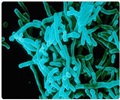Researchers have found traces of a monkey virus that contaminated the polio vaccine in the early 50's in a common form of highly malignant human cancer that has mystically doubled in incidence over the past 30 years. Two studies, found a link between the virus, called SV40, and non-Hodgkin lymphomas, a disorder ranked fourth or fifth among cancer deaths in the United States among women and men, respectively.
Results suggest that the virus may play a much wider role in cancer than previously suspected. Dr. Janet Butel, a lead researcher of the study at Bayor College, No obvious risk factors have emerged for non-Hodgkin lymphoma in the general population, but a viral cause has been postulated,'' said a group of eight researchers at Baylor College of Medicine in Texas led by Dr. Janet Butel. ``This finding sheds new light on the possible genesis of (this) important group of malignant disorders.''The scientists added that their findings may also offer hope for new therapies for the malignancies. The Salk polio vaccine, administered by injection in the United States and worldwide from 1950 through 1960, was grown on minced kidney tissue from rhesus monkeys.
At the time, the manufacturing process was considered safe. But in 1960, it was discovered that large batches of the vaccine were contaminated with the simian virus later named SV40. An estimated 90 million Americans received Salk vaccine injections and as many as 30 million were exposed to the virus.
In laboratory tests, hamsters injected with SV40 developed a variety of malignant tumors, but early government studies indicated that the virus appeared to have no negative effect in humans who had been exposed. That view began to change in the 1990s when DNA detection techniques became much more refined and evidence of the virus started showing up in human tumors. The group included rare brain, bone and lung-related cancers called mesotheliomas.
Other research has also turned up SV40 in tumors of children and adults born after the contaminated vaccine was taken off the market in 1963, leading to the still-unsolved mystery of how the virus is being transmitted. Friday's reports indicate that SV40 may be involved in a much broader group of human cancers, playing a possible role in nearly half of the 50,000 new cases of non- Hodgkin lymphoma diagnosed annually.
The cancer, which can be highly aggressive, has been associated with HIV-positive patients, and it was thought that the suppression of the immune system in these patients may have had a connection with the dramatic increase in lymphomas since 1970.
Advertisement
The second group of researchers were at the Fred Hutchinson Cancer Research Center in Seattle and the University of Texas Southwestern Medical Center in Dallas. Remarkably, both groups of researchers using slightly different detection techniques came up with almost identical results: SV40 fragments were found in 42 percent of 154 lymphomas sampled in one study, while the other found 43 percent in 68 cases.
Advertisement
But The Chronicle found that more than 60 studies from 30 laboratories around the world have reported detections of the virus in human malignancies. Dr. Jay A. Levy, a renowned virologist ``I've been in meetings where people say there is nothing to it,'' said at the University of California at San Francisco. ``That attitude is wrong.''
Levy said he had carefully reviewed the papers published Friday and was impressed with the research. ``You just can't walk away from it,'' he said, noting that the association found was very strong. ``But there is still quite a difference between association and causation,'' he added, ``and proving causation is very difficult.''
Dr. Adi Gazdar of the University of Texas, who led the second study, said yesterday that the ``data is very, very solid.'' He said it had to be more than coincidence that the four types of tumors found in hamsters after injection with SV40 - brain, bone, mesothelioma and lymphomas - are now exactly the same tumor types in humans found with detectable levels of SV40.
``The chances are 10 million to 1 it is a coincidence,'' he said. Evidence of how the virus works in tumors is growing as research shows that proteins from SV40 have a powerful effect in turning off tumor suppressor genes in humans.
Gazdar and the other researchers said that the recent SV40 discoveries also could help lead to effective cancer treatment, by using SV40 as a target for therapies. ``A vaccine targeting SV40 in mesothelioma is now being developed,'' he said. ``But it's still only a potential therapy, and we don't know if it will work yet.''
He said that U.S. officials have all but ignored the SV40 detections and that government funding and support for research has been nonexistent. One reason given by Gazdar and other scientists is that the government is worried about its role in promoting polio vaccination campaigns in the 1950s.
Jackie Kennedy And maybe it's because the first SV40-related cancers that were discovered were such rare ones,'' Gazdar said. ``But you can't ignore lymphoma; it's too widespread and too important a cancer. Jackie Kennedy and a lot of other well- known people have died from it.''











